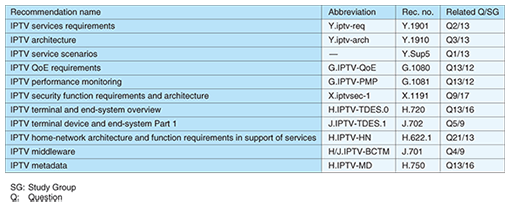 |
|||||
|
|
|||||
|
Special Feature: NGN Focus Vol. 7, No. 11, pp. 10–12, Nov. 2009. https://doi.org/10.53829/ntr200911sf2 IPTV Services and Standardization ActivitiesAbstractInternet Protocol Television (IPTV) services are expected to become a prime example of content-delivery services using the Next Generation Network (NGN). This article describes the IPTV business structure, methods for achieving typical IPTV services, quality considerations such as those for video in the retransmission of digital terrestrial broadcasts, and international standardization trends for IPTV.
1. IntroductionMany types of video and audio media are now being converted to digital form, giving users the option of choosing non-physical delivery instead of physical media such as compact discs (CDs) and digital versatile discs (DVDs). For example, music and video can now be recorded onto Flash memory or hard disks and used as desired. One means of delivering content without having to use specific physical media is broadcasting and another one is streaming via communications networks. Environments for making use of networks like this are now being put into place. Today’s always-on network connections mean that one can listen to or view content at any time. Consequently, users may find it unnecessary to record or save it. In this way, through changes in content delivery media and the establishment of content business using communications networks, new business markets are being formed. 2. IPTV services on the NGNA wide variety of communications services can be provided on the Next Generation Network (NGN): one of the most important is Internet protocol television (IPTV). A multicast-protocol-using broadcaster on the telecommunication services of a telecommunications service provider must be registered in accordance with the law concerning broadcast on telecommunications services [1]. The telecommunications service provider may be different from the network provider or the IPTV service provider. IPTV services can be broadly divided into two types: (1) services that use a multicast configuration (multicast services) like broadcasting does and (2) on-demand services that deliver content in unicast mode in response to individual requests from viewers. Both types can provide video with a quality level as high as high-definition-class digital broadcasts. 2.1 Multicast servicesMulticast services are configured in the same way as digital broadcasts: programs are arranged along the time axis on a channel-by-channel basis and the viewer can use an electronic program guide to select a program to view. Content consists of both programs procured by the IPTV service provider and simultaneous retransmissions of digital terrestrial broadcasts. For simultaneous retransmission, viewers often demand a viewing experience as good as direct reception of broadcasts from the broadcaster, so much attention is being paid to the quality of experience (QoE) in the retransmission of digital terrestrial broadcasts. At present, providing such services at the speeds available over the broadband networks used by most viewers requires transcoding to high-quality, high-compression video such as H.264 and content encryption for content protection. This necessarily involves processing delays in the delivery system. It is important to achieve a balance between the cost of greater processing speeds and the level of viewer satisfaction provided. 2.2 On-demand servicesVideo on demand (VOD) is a typical example of an on-demand service. A user searches for a particular program in various content libraries on the VOD server system by entering keywords such as part of the program title from the home screen (the first screen displayed when the service provider is accessed from a TV). If the desired program is found, the user may then watch it. Since on-demand services use unicasting, there is no need for the content to be saved in the receiver. Functions such as fast-forward, rewind, and pause can also be provided in unicast mode. 3. International standardization trendsIn general, establishing common specifications for IPTV systems should produce an economy-of-scale effect in manufacturing and enable the provision of high-quality and inexpensive IPTV services. As broadband services, including NGN services, have come to be deployed throughout the world, the International Telecommunication Union (ITU) has become active in IPTV standardization in addition to NGN-related activities. Japan has also been active in making proposals to ITU-T (ITU Telecommunication Standardization Sector) under the guidance of the Ministry of Internal Affairs and Communications (MIC). These proposals are divided into four technology fields: network architecture, QoE, content protection, and end systems. 3.1 Network architectureRecommendations concerning network-related functions for providing IPTV, the IPTV overall architecture, and IPTV overall requirements have been made. The delivery system has been divided into four function blocks: application functions, service-control functions, content-delivery functions, and network functions. On the basis of these function blocks, the work of making recommendations for the other technology fields is progressing. 3.2 QoERecommendations concerning QoE are being made with the aim of maintaining network quality in IPTV services. These recommendations cover network quality centered on quality of service (QoS), service QoE, and performance measurement points needed to maintain QoS and QoE. 3.3 Content protectionSince IPTV digital content is not degraded when copied, there is a need for technology that can limit its use to within the scope of contract conditions. Moreover, in the case of charged content, a function for processing the purchasing of content usage rights is needed. This function can be achieved in the form of a license processing function. Security functions involve technologies that cannot, by their nature, be fully disclosed, so standardization efforts are targeting a balance between security performance and disclosure range. 3.4 End systemsThe term end systems refers to the entire IPTV system in the home, which consists mainly of the home network and IPTV terminals. The home-network environment can be achieved by various connection formats including a wireless local area network, and the related standardization work takes into account the need to provide a stable IPTV connection environment. Studies have also begun on various types of terminals for implementing IPTV, from terminals targeting the most common types of services such as multicast streaming and VOD to portable terminals (e.g., mobile phones and personal digital assistants) and multifunction terminals. NTT is taking a proactive stance on IPTV terminal standardization with an eye to promoting the multicast and VOD services that have already been launched within the NTT Group. Specific recommendations are being made for IPTV-terminal internal functions divided into various aspects such as middleware, browser, discovery of and access to IPTV services, and error-correction methods at the application level. 4. Future standardization plansRecommendation work on IPTV standards related to overall requirements and basic functions commenced in 2006. This work was nearly completed by the middle of 2008, and the recommendations in question have since been approved or are now entering the approval process. These recommendations are listed in Table 1.
As for the IPTV services being provided in Japan, coordination with the other key regions and countries—Europe, North America, China, and Korea—participating in the standardization activities has nearly been completed. Looking forward, NTT plans to (1) make more detailed recommendations based on services in Japan, (2) promote more effective standards and reductions in provision costs, and (3) take the lead in proposing new services by drafting new international standards, and, at the same time, drawing up specifications for domestic use. Reference
|
|||||









